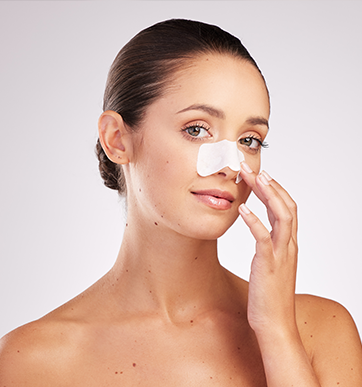
What to Do About Those Tiny Black Dots on Your Nose — AKA Sebaceous Filaments
Tiny black dots on your nose driving you dotty? Surprise! They’re not blackheads. Yes, they look like tiny flat blackheads—but they’re not. They’re sebaceous filaments. Now please put down that extractor, step away from the mirror, and read before you squeeze. Although sebaceous filaments are technically not acne, they’re on the spectrum.
Sebaceous Filaments – A Conduit for Nature’s Skin Moisturizer
You like your skin looking healthy and glowing, right? One key ingredient to that is moisturizer. And not just the kind you apply from a jar or tube. Your body produces its own moisturizer customized just for your skin. It’s called sebum. Sebum is the oily, waxy substance produced by your sebaceous glands. It mixes with fat molecules to form a protective coating on your skin’s surface.
Sebum moisturizes your skin from the inside out. But how does it get where it needs to go—the surface of your skin? For that, you can thank sebaceous filaments. Your skin is covered with hair, much of it nearly invisible. Each hair grows from its own hair follicle. And each follicle has attached to it a minuscule tube through which sebum is conducted up to the surface of our skin. This is a sebaceous filament.
When Sebaceous Filaments Get Ugly
Sebaceous filaments are basically your friends. They help keep your skin moisturized and healthy. But some people’s sebaceous glands produce an excess of sebum, which we call oily skin. Then, sebum can become too much of a good thing. And it can literally clog up the works. If the outermost tip of the sebaceous filament gets too much oil, it can enlarge the pores and trap tiny particles of dust and dirt.
For many people, sebaceous filaments may never become super visible. But for those with oily skin, it might look like you’ve got a sprinkling of poppy seeds embedded in your oily T zone—especially on and around your nose.
Why You Shouldn’t Squeeze Sebaceous Filaments
Never attempt to squeeze sebaceous filaments. It’s pointless and not worth the risk of damaging your skin. Whenever you squeeze—especially if you have long fingernails—you might redden and puncture your skin, possibly causing permanent scarring.
Blackheads, which flare up anywhere in the oily zones of your face, back, or chest, can be extracted by a skin care professional and may never come back. Sebaceous filaments are a different story. You can’t get rid of them. They are part of your body’s micro anatomy. Squeeze them and some sebum may ooze out. But the sebaceous filaments will fill back up again. That’s their job.
How to Clean Up Sebaceous Filaments
While sebaceous filaments can’t be eliminated, you can reduce their appearance temporarily. The black flecks that may form on your skin’s surface can be managed with gentle exfoliation. The best way to do this on a regular basis is by cleansing with oil-regulating products formulated for acne. Use an exfoliating face wash with salicylic acid and glycolic acid such as California Skin Institute’s Acne Cleanser. These ingredients are formulated to cut through the oil on your skin’s surface to clear away any dirt, bacteria, and dead cells that can accumulate at the tips of the sebaceous filaments.
Another easy way to incorporate salicylic acid and glycolic acid into your routine is by using California Skin Institute’s Acne Pads. Gentle yet effective, these pre-soaked rounds offer a combination of these acids in a soothing, toning witch hazel blend to keep your skin radiant and your pores clean.
If you have a special occasion or event coming up and you want to ensure that your skin looks absolutely clear, you can make an appointment to visit your board-certified dermatologist or advanced practitioner for a session of medically safe extractions. In addition, there may be medically prescribed treatment options such as retinoic acid that may be possible options for you and your sebaceous filaments. An occasional peel, microdermabrasion treatment or exfoliating facial may also be helpful.
Request an appointment at a California Skin Institute location near you.



 / 291 Reviews
/ 291 Reviews